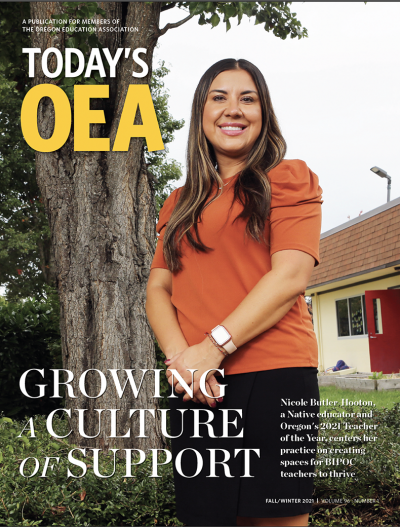OEA is committed to ensuring the health and safety of our members and the students they serve. In light of the novel Coronavirus epidemic, we will continue to advocate for each of you to our local, state and federal leaders and are continually searching for additional ways we can support Oregon’s students and educators during these uncertain times.
What is OEA doing to support educators and students during school closures?
OEA leadership and staff are working tirelessly to advocate for both educators and students during this time of uncertainty. That includes being in regular communication with the Governor’s office, the Oregon Department of Education and the Bureau of Labor and Industries to both receive new information from state leaders that we can share with you, and pushing those leaders for clearer guidance aimed at protecting students and educators.
Additionally, our leadership, our staff, and our legal team are working to push districts to make every educator fully whole during the school closures. While we will continue to work at the district-level to try and secure agreements for all public education employees to receive pay during the shutdown, we will also continue to urge the Governor’s office to issue statewide guidance instructing districts to do so.
How can I help my community during this time?
Our state and our nation are facing an unprecedented challenge. As our elected officials make the difficult decisions about temporarily shutting down public life, we must find ways to work together and offer our support to keep our community healthy and safe. OEA will be coordinating with school districts and with state agencies about ways we can help others. This includes volunteering to distribute meals to students and providing childcare to medical professionals who are working on the frontlines of keeping our community safe during this pandemic.
If you are at high-risk from coronavirus, or live with someone else who is at high-risk, please do not volunteer. The CDC has said high-risk individuals include: older individuals (60+); individuals who are immune-compromised; and individuals with chronic medical conditions such as heart disease, diabetes, lung disease or other conditions. The CDC does not have evidence that indicates pregnant individuals are at higher risk for contracting coronavirus, but out of an abundance of caution we ask that if you are pregnant or live with someone who is pregnant, that you refrain from volunteering.
You can find a list of volunteer opportunities, and a contact form to learn about additional ways to support your community at: https://bit.ly/OEAcovidvolunteer.
How will school employees be treated during the closures?
New guidance released by Governor Kate Brown on the evening of March 17th, 2020, made clear that all Oregon school districts would receive allocations from the State Schools Fund as if the closure period had not occurred – and directed all Oregon public schools to pay all employees during the closure.
It is not clear what this guidance means for substitutes, but we are working with the governor’s office to receive additional clarification and are advocating that long-term substitutes also be kept financially whole during the prolonged closure of Oregon’s schools.
We are also advocating to keep our community college staff safe and financially whole. So far, our higher education institutions have not been closed as many of them work to switch over to online and virtual programs.
Can I be forced to return to work during the school closures?
The short answer is yes.
In order to continue receiving funding from the State School Fund, districts must meet four mandates handed down by Governor Kate Brown. Those mandates include:
- Providing supplementary education to students.
- Nutritional services for students must be maintained.
- Childcare must be provided for emergency personnel and first responders.
- All district employees must continue to be paid.
School districts have been given the authority to call employees back to work in order to fulfill these mandates and continue to receive state funding.
On March 24th, ODE instructed superintendents that to the greatest extent possible, they must facilitate telework and work-from-home for employees, and that work in buildings is prohibited whenever a telework or work-from-home option is available.
Guidance released by Governor Kate Brown on the evening of March 17th, 2020, directed school districts not to call employees who fall into a high-risk category, or who live with someone in a high-risk category, back to work. OEA is seeking additional guidance on how employees should handle disclosing relevant health information to their school districts.
If you are being pressured to return to work and fall into any high-risk category or live with someone who falls into a high-risk category, please immediately reach out to your local OEA staff member.
How long will school closures last?
Gov. Kate Brown has directed all Oregon public schools to remain closed for the remainder of the 2019-2020 academic year.
That guidance also directed K-12 districts to put systems in place that would maintain nutritional services for students and to continue mental health services for children and their families.
All K-12 districts have been instructed to pay their employees during the closures.

